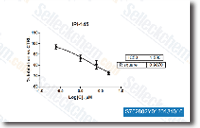Here, we existing clear evidence of practical expression of UTP delicate P2Y receptors in TIC cultures, suggesting a function for these receptors in ovarian physiology. RT PCR and Western blot studies indicated that cul tured TIC express P2Y2 and P2Y6 receptors. In func tional experiments, UTP and UDP, precise agonists for P2Y2 and P2Y6, respectively, induced robust Ca2 signals in regular Krebs or in Ca2 totally free resolution, which indicated the nucleotides promoted the response mainly by means of Ca2 release from intracellular reservoirs, in agreement with the canonical Gq PLC pathway for these receptors, UTP or substantial concentrations of UDP also induced the phosphorylation of MAPK p44 and p42, at higher concentrations, UDP acted principally over the P2Y2 receptor, considering the fact that P2Y6 is stimulated by UDP inside the low uM variety, Phosphorylation of MAPK was inhibited by suramin, a potent antagonist for P2Y2 and weak for P2Y6, but it was not affected by PPADS, that’s inactive toward P2Y2 but in a position to antagonize P2Y6 activa tion, Taken together, our information indicated a major role in the P2Y2 receptor in MAPK activation.
There may be ample proof that these protein kinases are involved with the proliferative phenomenon activated by G protein cou pled receptors in many cell systems, moreover, p44 and p42 MAPK selleck chemicals EPZ005687 activation dependent on P2Y2 or P2Y6 receptors has become described, e. g, in gran ulosa luteal cells, glioma cells, and embryonic stem cells, Staurosporin or long lasting incuba CYT997 tion with PMA blocked  UTP induced p44 and p42 MAPK phosphorylation. On top of that, p44 and p42 MAPK phosphorylation was blocked in BAPTA loaded cells, strongly suggesting that a calcium dependent PKC par ticipates within this response. Activation of MAPK p44 and p42 is directly linked to induction of cell proliferation, Our success demon strated that UTP and UDP induced a robust proliferative response much like that of 10% FBS made use of as favourable con trol.
UTP induced p44 and p42 MAPK phosphorylation. On top of that, p44 and p42 MAPK phosphorylation was blocked in BAPTA loaded cells, strongly suggesting that a calcium dependent PKC par ticipates within this response. Activation of MAPK p44 and p42 is directly linked to induction of cell proliferation, Our success demon strated that UTP and UDP induced a robust proliferative response much like that of 10% FBS made use of as favourable con trol.
CETP Signal
CETP is a member of a class of drugs
